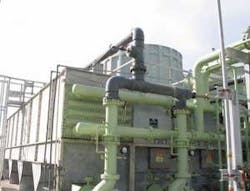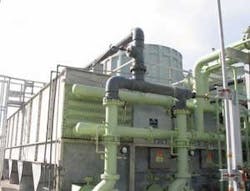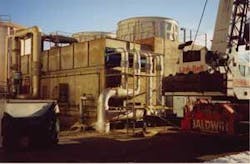Closed-Loop, Evaporative Technology Cools and Conserves Resources
New York company relates three wastewater solutions for Texas refinery, Mid-East petrochemical facility, and Australian power plant
By Peter Demakos, P.E.
Water availability and water quality has become an important consideration for industrial facilities worldwide. Closed-loop, evaporative cooling systems optimize use of scarce water resources. In addition to providing cooling solutions for wastewater facilities, the Wet Surface Air Cooler (WSAC) can use low quality water from almost any other source as spray makeup.
Multiple Applications
Niagara Blower Co. has engineered WSACs for wastewater systems in various industrial applications, including power, primary metal, petrochemical, refinery, and food & beverage facilities. Uses include influent or effluent cooling in biological treatment, thermal pollution control, inter-stage evaporation in limited discharge systems, evaporation of flue gas desulfurization (FGD) water, and as a first stage evaporator upstream of dryers, crystallizers and other zero liquid discharge (ZLD) systems.
The use of Niagara WSACs in biological wastewater treatment has successfully proven very beneficial, as the microbes need to be kept within a narrow temperature range.
Since the WSAC is an evaporative cooling device, it has an operating approach (leaving fluid temperature) to the ambient welt bulb, not the dry bulb as with air cooled units. This allows the process outlet stream to be much cooler than the alternative system designs. This WSAC provides single-source thermal responsibility and has shown to be a viable solution to control cooling capacity – better than other types of heat exchange systems
WSAC technology combines elements of a tubular heat exchanger and cooling tower in a single structure. This is a cost-effective heat transfer technology providing lower outlet temperatures while requiring less space and operating HP.
Warm process fluids or vapors are cooled in closed-loop tube bundles. The process fluid being cooled never comes in contact with the environment. Open-loop water is sprayed and air is induced over the tube bundle exterior resulting in the cooling effect.
Due to the closed-loop tube bundle design and the wide tube spacing, low quality water (even that with suspended solids) can be reused with high levels of concentration.
Each WSAC is custom designed to fit a specific heat transfer application. To ensure efficient operation in all climates, design parameters are based on customer specifications for inlet and outlet temperatures, as well as average weather conditions.
Units can be manufactured with a wide variety of materials depending on water quality, water treatment and cycles of
concentration. WSAC equipment is tailored to meet the unique needs of the most demanding applications in the world. Niagara Wet Surface Air Coolers vary in size from smaller packaged skidded to large field-erected units.
Three Recent Projects
- Texas Refinery Water Treatment – A Fortune 500 refiner needed to cool plant wastewater, with water and material quality as important factors in the search for a rugged, industrial system. Upon being selected to provide a WSAC to cool the high fouling, high solids, high chlorides wastewater at this plant, Niagara engineered a large field erected unit with a concrete basin and 316L stainless steel tube bundles. The unit provided the ability to maintain critical wastewater outlet temperature during one of the hottest summers on record.
Because of the essential nature of cooling requirements to the system, the unit included redundant standby tube bundles, fans and pumps to allow for scheduled servicing and maintenance while still in operation. The built-in redundancy allows the facility to stay running year round without shutdown.
- Petro-Chemical Wastewater Treatment in the Middle-East – Niagara provided a field erected, multi-cell cooler with an all FRP structure and prime surface tube bundles for a Middle-Eastern petro-chem wastewater treatment plant. The WSAC designed for this facility allowed for observation and maintenance of the spray water distribution system without need for structure entry or fan shutdown.
An important design feature for this unit is individual tube bundle installation and removal by a vertical lift without affecting the operation of fans and remaining tube bundles.
The straight-through, mechanically cleanable individual tube bundles are hydraulically isolated for service or control. A self low-pressure, high flow draining spray system, which includes large orifice non-clogging spray nozzles, was designed so all spray nozzles can be inspected and serviced without removing any appurtenances while the equipment is in operation.
- Reusing Water to Condense Steam in Australia – A WSAC steam condenser was engineered for a natural gas powered 25 MW power plant in Australia. Due to the poor quality of the water reused, as well as ambient air effects on external surfaces of this WSAC, corrosive resistant coil material and protective surface finishes were selected.
Regular service and cleaning is recommended for maintaining optimal performance, especially when poor quality water is used. Prime surface cleanable condensing coils offer complete internal access for inspection and cleaning, while an unobstructed view from above the tube bundles of the recirculating spray system and the outside tube surfaces permits easy visual inspection.
This view is obtained by way of an external access package which was provided on this unit. This WSAC included a ladder, cage walkway and handrail.
WSACs offer several advantages for similar sites with poor quality makeup, including a reduction of fresh water make up, the ability to reduce plant wastewater, and the ability to obtain higher cycles of concentration.
null
Conclusion
Issues such as water conservation will continue to have an increased impact on plant design and operation. Closed-loop, evaporative coolers can help maintain plant performance while utilizing water streams that are currently unusable with conventional towers and heat exchangers.
Author’s Notes:
Peter Demakos, P.E., is president of Niagara Blower Co., a Buffalo, New York-based design-build manufacturer of engineered solutions to heat transfer applications at power, process, refinery, food and brewing facilities worldwide since 1904. Contact: 716-875-2000 or www.niagarablower.com


